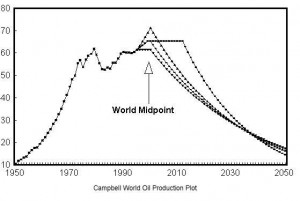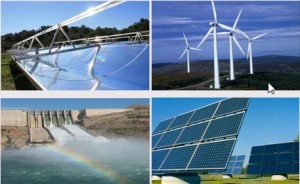ENERGY
We are depleting the conventional (fossil fuel) resources in our world. Based on the ultimate oil production estimates, it is expected that production will drop over the years, consistently with the below graph. The graph predicts various scenarios going forward, all of which are alarming. Alternate sources must be deployed through the widespread use of renewable energy.
Graph showing Production (Mbd – Millions of barrels per day) against Time (Years), based on Dr. C. J. Campbell’s data[1]:
Global Warming
Use of fossil fuels has been the main source of CO2 emissions, which cause heat trapping green house effect[2]. Global warming is the result of the excessive green house gas (GHG) emissions, and has many negative consequences like hotter and drier summers, increase in heat-related illnesses, melting of the ice caps, flooding, etc. The Intergovernmental Panel on Climate Change (IPCC) predicts a warming in the range of 2.5 to 10.4 degrees Fahrenheit by the year 2100. During the 20th century the global average surface temperature has increased about 1 degree Fahrenheit. This is likely to have been the largest increase of any century during the past 1,000 years. As a result we are already observing various effects of this warming. Snow and ice cover are decreasing, including a widespread retreat of mountain glaciers in non-polar regions during the 20th century. Sea level is rising and the heat content of the oceans has increased. Precipitation and extreme weather events also appear to be increasing.
Courtesy NOAA, Dave Keeling and Tim Whorf (Schipps Institution of Oceanography)
Carbon dioxide concentration as measured at Mauna Loa, Hawaii
Global Response
Global Energy need is expected to increase by %44 between 2006 and 2030. The above picture, however, is not sustainable. Achieving the “high” range mitigation potential therefore have required quantitative targets and policy actions to reduce GHG emissions around the globe. Some officially available sample targets are:
- 14-17% GHG emission reduction between 2005-2020 in USA[3]
- 20% GHG emission reduction between 1990-2020 in E.U.[4]
It is well recognized that increased use of renewable energy sources is a “must” if these targets are to be met. Various goals of renewable energy use have also been legislated:
- Renewable energy 12% of total by 2010 in EU-15[5]
- Renewable energy 10% of total by 2011 in US[6]
- Renewable energy 10% of total by 2010 in Latin America/Caribbean[7]
In addition to renewable energy technologies, another critical area is the efficient distribution and use of the existing energy resources. Energy efficient design and application is a crucial focus topic for all industries, including the ones that deal with high power systems, industrial or domestic environments, or microelectronics. The recent energy efficiency thrust can be easily distinguished in the modified mission statements and activities of large international companies, governmental and non-governmental organizations.

[2] http://www.coalitionforcleanair.org/air-pollution-global-warming-faqs.ht...
[3] http://www.wri.org/publication/usclimatetargets
[4] http://register.consilium.europa.eu/pdf/en/07/st07/st07224-re01.en07.pdf
[5] http://eur-lex.europa.eu/LexUriServ/LexUriServ.do?uri=CELEX:32001L0077:E...
[6] http://www.renewableenergyworld.com/rea/news/article/2009/02/renewable-e...











